Tata Harrier EV RWD vs Hyundai Creta EV: Price, variants, specs compared

Tata Motors today announced the full price list of the new Tata Harrier EV RWD. Tata Motors had earlier revealed just the starting price of the Harrier EV. The price for the EV SUV starts at ₹21.49 lakh and goes up to ₹27.49 lakh (ex-showroom). This is Tata’s most powerful, tech-loaded, and feature-rich EV so far, and it also debuts its first all-wheel-drive setup in an EV. Bookings for the RWD version open on July 2, 2025. You can book it online or by heading to your nearest Tata showroom. The Harrier EV compete with the Mahindra XEV 9e and Hyundai Creta EV.
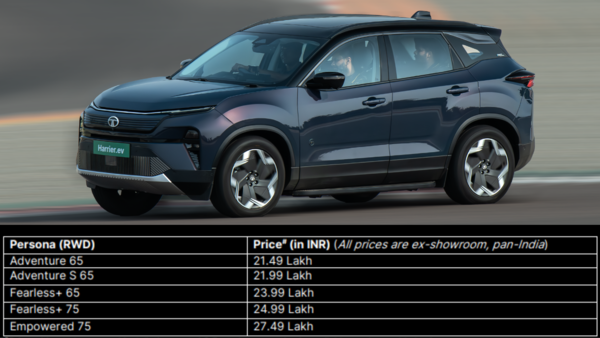
Tata Harrier EV RWD vs Hyundai Creta EV: Variants, PriceThe rear-wheel-drive version of the Harrier EV is available in five trims, paired with two battery configurations – 65 kWh and 75 kWh. The 65 kWh option is offered in the Adventure, Adventure S, and Fearless Plus variants, priced at Rs 21.49 lakh, Rs 21.99 lakh, and Rs 23.99 lakh respectively (ex-showroom). Meanwhile, the 75 kWh battery is available in the Fearless Plus and Empowered variants, priced at Rs 24.99 lakh and Rs 27.49 lakh (ex-showroom). Pricing for the top-spec Empowered AWD variant is yet to be disclosed. Buyers should note that the AC fast charger and its installation will be billed separately.
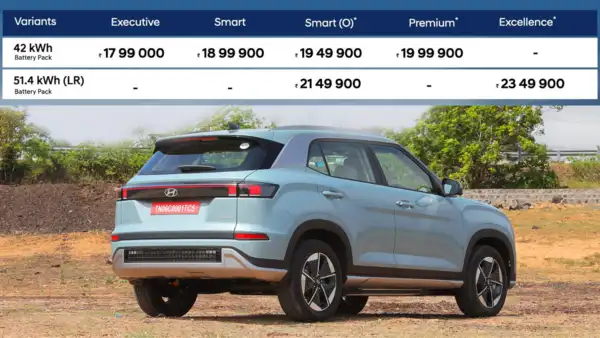
The Creta Electric is offered in five variants– Executive, Smart, Smart (O), Premium, Excellence and two battery pack options – 42 kWh and 51.4 kWh. The 42 kWh is offered in four trims Executive, Smart, Smart (O), and Premium priced at Rs 17.99 lakh, Rs 18.99 lakh, Rs 19.40 lakh and Rs 20.0 lakh (all prices, ex-showroom). The larger 51.4 kWh battery pack option is offered in two variants – Smart (O) and Excellence priced at Rs 21.5 lakh and Rs 23.5 lakh (both prices ex-showroom).Tata Harrier EV RWD vs Hyundai Creta EV: Battery, range, e-motorThe new Tata Harrier EV RWD is offered with two LFP battery pack options – 65 kWh and 75 kWh. Both come paired to a single e-motor placed on the rear axle, pushing 238 hp of power. There’s also the AWD variant that gets a 75kWh LFP battery and dual electric motors—one on each axle—delivering a total output of 313 hp and 504Nm of torque. With Boost mode activated, this version can accelerate from 0 to 100kph in just 6.3 seconds.
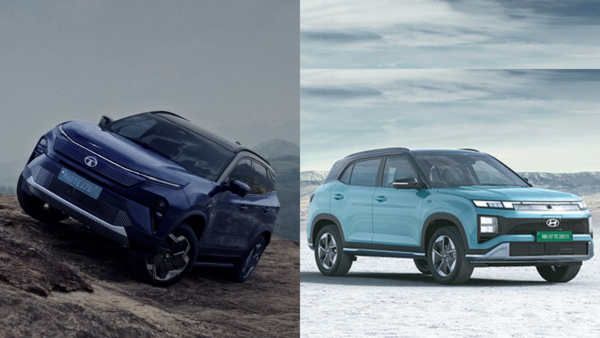
Talking about the range, the Harrier EV’s 75kWh RWD and AWD versions offer an MIDC-certified range of up to 627km and 622km, respectively, on a full charge. Talking about the charging, the SUV takes approximately 10.7 hours to go from 10 to 100 per cent using a 7.2kW AC charger, while a 120kW DC fast charger can top up the battery from 20 to 80 per cent in just 25 minutes (both claimed).The Hyundai Creta Electric is offered with two battery options – 42 kWh and 51.4 kWh packs with an ARAI-rated range of 390 km and 473 km, respectively. The battery pack comes paired with a single electric motor which puts out 135 PS with the smaller battery pack and 171 PS with the larger 51.4 kWh battery pack. Using a DC fast charger, the EV can go from 10% to 80% charge in 58 minutes. An 11 kW AC home charger requires 4 hours to fully recharge the battery from 10% to 100%. The long-range variant can sprint from 0 to 100 kph in 7.9 seconds. It also gets three modes – Eco, Normal and Sport, as seen on the Ioniq 5 the Creta EV also features a steering column-mounted drive mode selector and also features single pedal driving which Hyundai calls i-Pedal technology.Tata Harrier EV RWD vs Hyundai Creta EV: FeaturesIn terms of features, the new Harrier EV gets a larger 14.53-inch infotainment screen with a Samsung Neo QLED display, a 10.25-inch digital driver’s display, a four-spoke steering wheel with an illuminated Tata logo, a touch-based HVAC control panel, a rotary selector for the six terrain modes – Normal, Snow/Grass, Mud-Ruts, Sand, Rock Crawl, Custom – and electronic parking brake. Other features include a panoramic sunroof, ambient lighting, ventilated and powered front seats, powered Boss mode for the second row, 10-speaker JBL sound system with Dolby Atmos 5.1, powered tailgate, vehicle-to-load (V2L) and vehicle-to-vehicle (V2V) functionality, all-digital inside rearview mirror, and auto park assist.
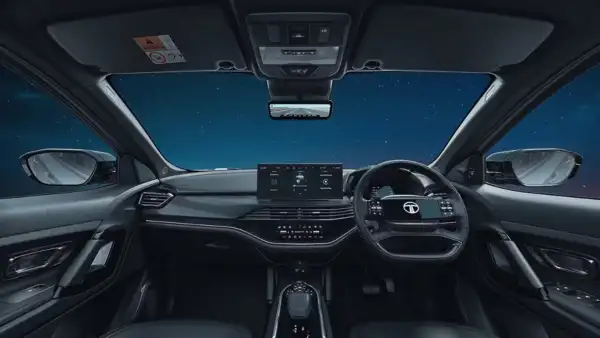
It also gets TiDAL (Tata Intelligent Digital Architecture Layer) that powers the SUV’s connected car features, such as over-the-air (OTA) updates, voice commands, a 540-degree surround camera, and a new DrivePay feature that eliminates the need for a mobile device for FASTag and EV charging point payments. Safety-wise, the EV gets seven airbags, a 360-degree camera, a built-in dashcam, a car blind spot monitor, electronic stability control (ESC), Level 2 ADAS and more.
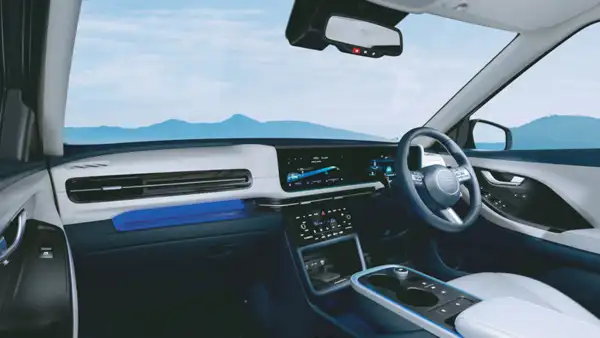
Features-wise, the Creta EV gets dual 10.25-inch screens – one for the infotainment and one for the instrument cluster and it will also get a new steering wheel as seen on Kona sold overseas. Other features include a panoramic sunroof, ventilated and powered seats, automatic climate control, vehicle-to-load (V2L) technology, 360-degree camera, digital key and ADAS suite. The Creta EV also comes with Level 2 ADAS, offering features such as Lane Keeping Assist, Forward Collision Warning, Blind Spot Collision Warning, and Smart Cruise Control with stop-and-go functionality.The Creta EV also features V2L (Vehicle-to-Load) which allows the vehicle’s battery to supply power to external devices or appliances. It essentially turns the EV into a mobile power source, enabling users to charge or operate various electrical devices, such as laptops, camping equipment, or even home appliances, using the stored energy in the car’s battery.





